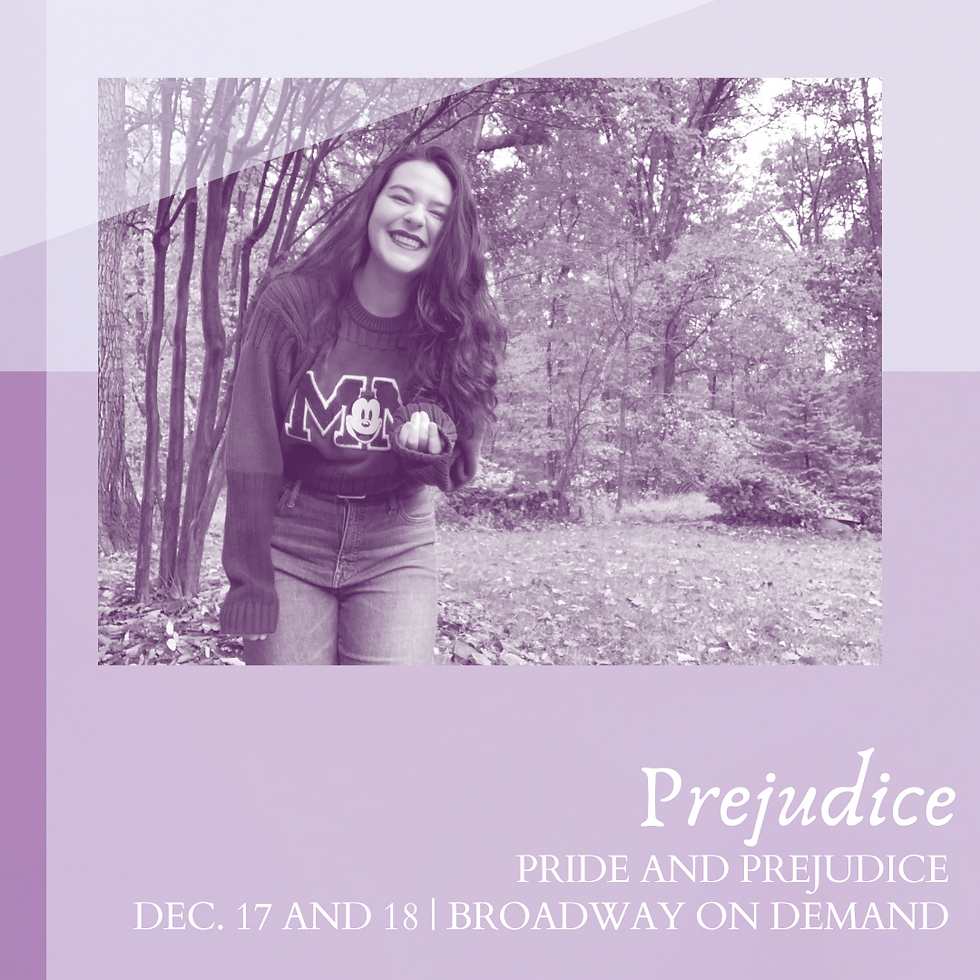top of page
Pride and Prejudice
AU Rude Mechanicals, November 2020
by Jane Austen
adapted by Jon Jory
Directed by Katie Hoffkins
Assistant Directed by Anna Wang
Dramaturg/Lady Catherine de Bourgh – Siena Maxwell
Production Team of 11, Cast of 18
Click here for the program with all the information.
Link to trailer below.


83

81
Describe your image

73
Describe your image

83
1/12
Pride and Prejudice Trailer
AU Rude Mechanicals, November 2020
Directed by Maya Costanzo
Edited by Siena Maxwell & Olivia Kozlevcar
Sound by Siena Maxwell
Featuring Isabelle Verdino, Evan Janke, James Speaks, Cate Longino, and Siena Maxwell
Featuring "Impromptu No. 3 in G-Flat Major, Op. 90, D. 899" by Franz Schubert
Dramaturgical Materials
Dramaturg's Note
"Being one of the most celebrated works of all time, Jane Austen's (1775-1817) Pride and Prejudice offers a wealth of research opportunities. Written under the apt working title, “First Impressions,” it took Austen sixteen years to finally get the novel published in three volumes, becoming the second of her seven total novels, four of which were published during her lifetime anonymously due to her sex. The novel is likely based on her own life experiences, pointedly her relationship with her sister, and shared unrequited love with Irish politician, Tom Lefroy. Austen never married and only lived until the age of 42, but still retains a formidable legacy to this day.
Pride and Prejudice originally takes place during the Regency Period in British history, specifically in 1813, a tumultuous time colored by major military events like the Napoleonic Wars (1803-1815) and the War of 1812 (1811-1814). During this period under the young “Playboy Prince,” British interest and support of literature increased, with the Romantic movement, the formation of more public libraries, and the invigoration of private libraries as displays of wealth.
As a “comedy of manners,” Pride and Prejudice deals with themes of class, gender, love, and misconception. The class structure of the time was strictly based on societal rank, a recurring topic found in Austen’s novels. Focusing primarily on the landed gentry, land-owning commoners of higher economic status, like the Bennets, Darcys, and Bingleys, Austen does still include the nobility through Lady Catherine and the lower echelons of society, like businessmen, army men, and clergymen. Austen comments on the expectations of women in her time, as well, through female inheritance complications, and matrimony viewed as an economic transaction rather than a bond of mutual love, which she pushes back against in her fiery characterization of Elizabeth Bennet.
Pride and Prejudice primarily exists within its own bubble, with characters never remarking on anything really beyond the immediate plot. However, with the military regiment and Mr. Wickam’s presence, Austen subtly interjects her own criticism of British militarization and its unwelcome effect on the lives of civilians during the period. With characters like a parson, a noblewoman, and a military officer all portrayed largely in a negative light, Austen certainly does not shy away from voicing her opinions on her society, being a member of the landed gentry herself, and critiquing conventions and their absurdities through her celebrated writing. Thus, Pride and Prejudice maintains its longevity through its author’s subtlety, nuance, humor, and historical insight into a bygone era. Enjoy!"
-Siena Maxwell, Dramaturg
Dramaturgical Presentation

Dramaturg's Presentation - Pride & Preju

Dramaturg's Presentation - Pride & Preju
Describe your image

Dramaturg's Presentation - Pride & Preju

Dramaturg's Presentation - Pride & Preju
1/94
bottom of page